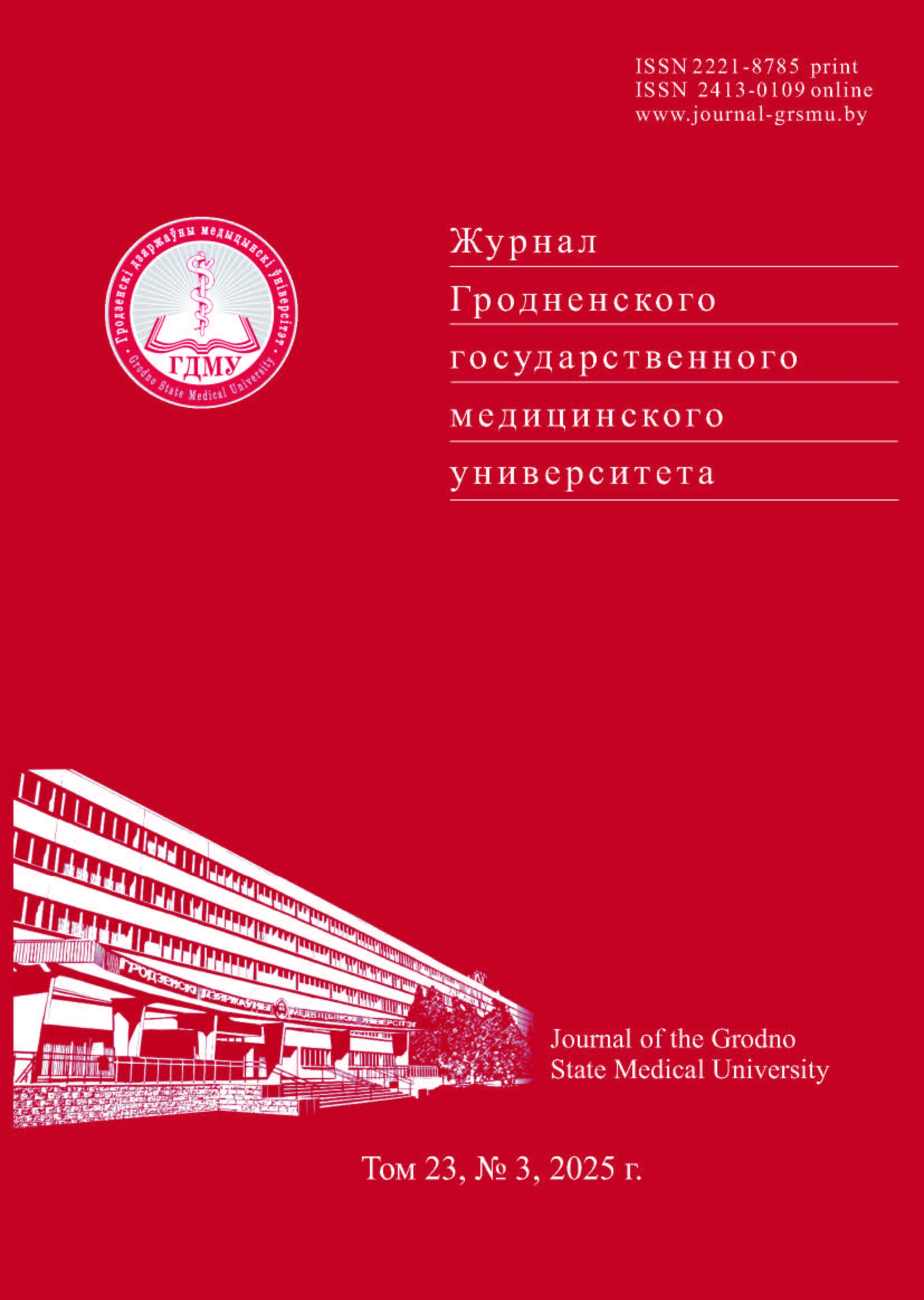СРАВНИТЕЛЬНАЯ ХАРАКТЕРИСТИКА СПОСОБОВ РЕКОНСТРУКТИВНОГО ЛЕЧЕНИЯ ДЕФЕКТОВ КОСТЕЙ ЧЕРЕПА
Аннотация
Введение. Пластика дефекта черепа аутотрансплантатом считается оптимальным способом краниопластики. Однако при невозможности сохранения костного лоскута возникает необходимость использования искусственных материалов. Важнейшим показателем успешности краниопластических операций является низкий уровень послеоперационных осложнений, которые требовали бы повторных оперативных вмешательств. Цель исследования. Оценить и сравнить результаты краниопластических операций с применением различных материалов. Материал и методы. Одноцентровое ретроспективное исследование медицинских карт стационарных пациентов, оперированных в нейрохирургическом отделении УЗ «Городская клиническая больница скорой медицинской помощи г. Гродно» по поводу наличия дефектов костей черепа за 16 лет (с января 2009 по декабрь 2024 года). Все пациенты были разделены на четыре группы. Первую группу составили пациенты, которым проводилась краниопластика аутокостью – 249 человек, вторая группа – пациенты, пластика которым выполнялась протакрилом – 70 человек. Третью группу (49 человек) составили пациенты с пластикой титановой пластиной и четвертую – 62 пациента с комбинированной пластикой (аутокость и титановая пластина). Результаты. Осложнения после краниопластики наблюдались у 16 (3,7%) оперированных пациентов и встречались во всех четырех изучаемых группах. Наибольший процент был при комбинированном способе (4,8%) без статистической значимости (p>0,05) по отношению к другим способам пластики дефекта чере- па. Среди осложнений встречались: эпидуральная гематома – у 10 (2,3%) пациентов, остеомиелит костного лоскута – у 4 (1,0%) пациентов, внутримозговая гематома – 1 (0,2%) и эпидуральная эмпиема – 1 (0,2%) пациент. Выводы. Использование искусственных трансплантатов для закрытий дефектов костей черепа статистически значимо (p <0,05) уменьшает время выполнения оперативного вмешательства по сравнению с применением аутокости, ввиду сокращения затрат времени на извлечение костного аутотрансплантата. Это способствует снижению количества осложнений и, кроме этого, исключает возникновение остеомие- лита трансплантируемого костного лоскута.
Литература
Bjornson A, Tajsic T, Kolias AG, Wells A, Naushahi MJ, Anwar F, Helmy A, Timofeev I, Hutchinson PJ. A case series of early and late cranioplasty-comparison of surgical outcomes. Acta neurochirurgica. 2019;161(3):467-472. https://doi.org/10.1007/s00701-019-03820-9.
Abdelaziz Mostafa Elkatatny AA, Eldabaa KA. Cranioplasty: A New Perspective. Open Access Maced J Med Sci. 2019;7(13):2093-2101. https://doi.org/10.3889/oamjms.2019.489.
Alkhaibary A, Alharbi A, Alnefaie N, Oqalaa Almubarak A, Aloraidi A, Khairy S. Cranioplasty: A Comprehensive Review of the History, Materials, Surgical Aspects, and Complications. World Neurosurg. 2020;139:445-452. https://doi.org/10.1016/j.wneu.2020.04.211.
Ong AA, Manning JP, Vincent AG, Namin AW, Wang W, Ducic Y. Cranioplasty. Facial Plast Surg. 2021;37(6):698-702. https://doi.org/10.1055/s-0041-1735560.
Ofitserov AA, Borovkova NV, Talypov AE, Ponomarev IN. Modern materials for the reconstruction of the cranial vault bones. Transplantologiya. The Russian Journal of Transplantation. 2019;11(3):234-243. https://doi.org/10.23873/2074-0506-2019-11-3-234-243. https://elibrary.ru/xwgldc. (Russian).
Thimukonda JJ, Baldia M, Basu B. Next-generation personalized cranioplasty treatment. Acta Biomater. 2022;154:63-82. https://doi.org/10.1016/j.actbio.2022.10.030.
Tsarukaev BA, Kravchuk AD, Latyshev YaA. Surgical treatment of patients with skull defects and cerebrospinal fluid flow disorders after previous decompressive craniectomy. Burdenkos Journal of Neurosurgery. 2023;87(6):114 119. https://doi.org/10.17116/neiro202387061114. https://elibrary.ru/eqeevgG. (Russian).
Leach GA, Dean RA, Cleary DR, Steinberg JA, Gosman AA. Custom 3D-Printed External Cranial Orthotic for Prevention and Treatment of Syndrome of the Trephined. J Craniofac Surg. 2023;34(7):e682-e684. https://doi.org/10.1097/SCS.0000000000009658.
Varyukhina MD, Vorobyev AN, Levin DV, Ilyina AA, Kolesov DL, A.A. Shaibak AA, Radutnaya ML, Yakovlev AA, Gorelova ES. Features of Cranial Bone Reconstruction in Patients at Various Stages of Rehabilitation. Physical and rehabilitation medicine, medical rehabilitation. 2022;4(2):83-89. https://doi.org/10.36425/rehab108760. https://elibrary.ru/dbcmxq. (Russian).
Yarikov AV, Fraerman AP, Leonov VA, Stolyarov II, Gunkin IV, Tsygankov AM. Skull defect surgery: a review of current techniques, materials and additive technologies. Amur Medical Journal. 2019;4(28):65-77. https://doi.org/10.22448/AMJ.2019.4.65-77. https://elibrary.ru/tfhyxr. (Russian).
Mee H, Anwar F, Timofeev I, Owens N, Grieve K, Whiting G, Alexander K, Kendrick K, Helmy A, Hutchinson P, Kolias A. Cranioplasty: A Multidisciplinary Approach. Front Surg. 2022;9:864385. https://doi.org/10.3389/fsurg.2022.864385.
Elshirbiny MF, Ahmed A, Amen MM. Autograft cranioplasty for skull defects in children. Interdisciplinary Neurosurgery. 2023;33:101789. https://doi.org/10.1016/j.inat.2023.101789.
Lee JH, Shim YW, Kim S, Lee WH, Lee KS, Paeng SH, Pyo SY. Clinical Outcomes of Cranioplasty Using a Customized Artificial Bone Flap Made by a 3D Printing Technique. J Neurointensive Care. 2021;4(2):52-57. https://doi.org/10.32587/jnic.2021.00388.
Siracusa V, Maimone G, Antonelli V. State-of-Art of Standard and Innovative Materials Used in Cranioplasty. Polymers. 2021;13(9):1452. https://doi.org/10.3390/polym13091452.
Shokri A, Vafaee F, Haghighat L, Shahabi S, Farhadian M, Jamalpour MR. Comparison of the amount of artifacts induced by zirconium and titanium implants in cone-beam computed tomography images. BMC Med Imaging. 2022;22(1):156. https://doi.org/10.1186/s12880-022-00884-5.
Biswas S, Alarcon G, Valentin A. Effects of metallic cranioplasty on electroencephalographic recordings: an illustrative case. Clin Neurophysiol. 2013;124(3):626-627. https://doi.org/10.1016/j.clinph.2012.07.011.
Liang Y, Xu H, Tang W, Du X. The impact of metal implants on the dose and clinical outcome of radiotherapy (Review). Mol Clin Oncol. 2024;21(4):66. https://doi.org/10.3892/mco.2024.2764.
Shepetovsky D, Mezzini G, Magrassi L. Complications of cranioplasty in relationship to traumatic brain injury: a systematic review and meta-analysis. Neurosurg Rev. 2021;44(6):3125-3142. https://doi.org/10.1007/s10143-021-01511-7.
Coulter IC, Pesic-Smith JD, Cato-Addison WB, Khan SA, Thompson D, Jenkins AJ, Strachan RD, Mukerji N. Routine but risky: a multi-centre analysis of the outcomes of cranioplasty in the Northeast of England. Acta neurochirurgica. 2014;156(7):1361-1368. https://doi.org/10.1007/s00701-014-2081-1.
Ha M, Lee JH, Choi HJ, Kim BC, Yu S. Postoperative infection after cranioplasty in traumatic brain injury: a single center experience. J Trauma Inj. 2022;35(4):255-260. https://doi.org/10.20408/jti.2022.0043.
Bikram S, Bidur KC, Amit T. Surgical Outcome of Exvivo Preserved Autologous Cranioplasty – A Novel Approach. Nepal Journal of Neuroscience. 2019;16(3):43-49. https://doi.org/10.3126/njn.v16i3.27355.
Dovnar AI. Creation of a personalized cranial implant with "Superfluvis" material. Neurology and Neurosurgery. Eastern Europe. 2024;14(1):50-58. https://doi.org/10.34883/PI.2024.14.1.045. https://elibrary.ru/ocmvip. (Russian).





























